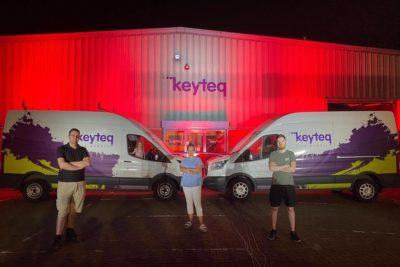Employees
How three business leaders are dealing with the end of the furlough scheme – from redundancies to disengagement
Now the furlough scheme has been extended, business leaders are working out how to bring staff back into the workplace – as well as making big decisions about headcounts.
We spoke to three business leaders in very different situations about using the furlough scheme, bringing people back to work and their advice for others facing tough decisions.

Bringing staff back to a three-day week
Cheshire-based live events company Keyteq furloughed ten staff during lockdown and kept five working in the business. This switched to flexible furlough when the business started doing virtual events like conferences and award shows.
Managing director Peter Rzeskiewicz said he was forced to make redundancies in October, when the furlough scheme was due to end.
“When we started looking at bringing people back from furlough, we had to make the decision to make redundancies. We went into the process looking at newer employees, who were kind of expecting it. Then we moved to more difficult, long-term employees,” Peter said.
For other business owners in a similar situation, Peter recommends speaking to a HR expert. You can discuss your options and check you aren’t about to make a mistake that could cost you further down the line.
Even with the diversification into online events, turnover is 20-40 per cent of what was expected. The extension of the Job Retention Scheme means Keyteq’s cash reserves are going to last longer.
Cash is what matters right now
Peter credits good cash flow management and a strong previous year for the company’s survival. However, you can’t rely on your reserves forever.
“Cash is the answer to everything at the moment. When the pressure is on to make decisions, you need to act quickly. I know people don’t want to make redundancies or do things that hurt people, but it’s about survival. If you run out of cash, you have no options whatsoever,” he said.
Despite the difficult decisions he’s had to make, Peter is optimistic about the future. He’s seen a shift in clients’ mindsets recently and is already hoping he’ll be able to bring most of the people they’ve lost back into the business.
“A lot of companies seem to have woken up to the fact that there isn’t going to be a bailout – they’ve got to do something. We’ve done more quotes for virtual events in the last four weeks than we have in the last six months. It leads us to think quite positively. We don’t need to make a lot of money, we just need to survive for as long as we can.”
The popularity of its online offerings led Keyteq’s team to build a second studio in its warehouse.
Project managers and technicians are being brought back from furlough to help run the studio through flexible furlough, which allows employers to put people on furlough for part of their hours.

Furlough impacts each employee differently
Reserve Wines started focusing on ecommerce when the first lockdown started. The company furloughed 32 of its 38 staff, which left six employees to help set up an online store and put the systems in place to cope with demand.
Owner Kate Goodman described the period as “chaos”, but added that the switch ultimately saved the business.
The company started bringing people off furlough gradually when its retail sites reopened in May and June, but they’re currently only able to open three of their five locations and have had to put members of staff back on furlough for a second time.
“We’ve worked hard to bring people back and make sure that reintegration has been as easy as possible. Now, some have had to go back to furlough,” Kate said.
For Kate, the biggest challenge has been reconciling some of the differences caused by lockdown and the furlough period.
“The interesting thing is how differently people experienced that period. It was great for some people because they’re artists or have other projects. But for other people, the lack of structure, focus and purpose was really difficult. Suddenly you have to bring all those people back and reconcile those differences,” she said.
Be quick with comms to reduce staff anxiety
Kate has tried hard to avoid redundancies, but has had to lose two members of staff. She worked with her HR advisor to map out the redundancy process in advance and used a mix of Zoom calls, phone calls and in-person meetings during the consultation period.
The priority, Kate said, was to make the process fair and reduce anxiety across the workforce.
“We were going to send out a message to staff on a Friday to say we needed a meeting on Monday, but we knew people would worry all weekend. We ended up doing the meeting on a Tuesday. People’s anxiety levels are high enough already, so we wanted to reduce that.
“Be quick with your comms so people know where they’re at, rather than hearing rumours and panicking. Follow a fair process. The feedback we got was that it had been done fairly and handled well, which is the only thing you can hope for in a fairly unpleasant situation.”
Kate stays in regular touch with the staff that are on furlough, to make sure that people aren’t isolated or feeling lonely.

Keeping people positive and mentally well
Coronavirus restrictions have changed the dynamic of people’s roles since returning from furlough. Three of Reserve Wines’ sites are in large food markets which now serve customers through app orders.
Kate explained that talking to customers about wine was something everyone loved about the job. Now that’s severely reduced and staff need to get used to a different way of working. She’s also had to tailor roles and shuffle people between sites, so a lot of staff aren’t working where they used to.
Good communication has been crucial in helping staff adapt to these changes. Kate knows that the uncertainty surrounding the hospitality industry is always playing on people’s minds, so she checks in with staff regularly.
“Things are in a state of flux. We’re always waiting on tenterhooks to find out whether we’re going to get closed down. I know people see things in the press and think, ‘how long will my job last?’ It creates a lot of anxiety.
“I reassure the staff that as soon as we know something, they will know. You have to keep people positive and as mentally well as you can.”
Kate recommends focusing on the things you can control at the moment. There will be new challenges in the next few months like the recession and Brexit, but those things are out of her control.
“All I’m thinking about is how we can get wine as easily as possible to our customers. Things will change – all you can do is work with it and keep breathing.”
The business is looking for opportunities too. The new website will go live just in time for Christmas and Kate’s looking at doing a series of pop-up shops.
Adjusting furloughed staff to fast-paced work

Bespoke furniture supplier Bluebell Fitted Furniture brought its staff off furlough at the start of June.
The company had a backlog of orders to fulfil and director Alison Reuben had been taking other enquiries during lockdown. They’re busier than they’ve ever been.
“We haven’t stood still since we returned. It’s been crazy – we haven’t been this busy in the 30 years we’ve been open. I think it’s because people have been sitting at home for months and want to spend money on home improvements rather than holidays,” she said.
The scale of orders coming in meant that Bluebell’s workforce didn’t have long to adjust to being back from furlough. Design and fitting teams also needed to enter people’s homes, which some staff worried about.
Review health and safety measures frequently
Alison followed advice from the Health and Safety Executive to make staff as comfortable as possible.
There are protective desk screens, sanitiser stations and one-way systems in the office and showroom. Customers have to send back a signed COVID-19 declaration form before a Bluebell employee enters their home too.
The surreal experience of recruitment
Bluebell recruited a new designer two weeks ago and is currently hiring for three new roles. It’s a surreal experience for them to be hiring four people in a short space of time, particularly in the current climate.
“We never in a million years expected this. During lockdown, we thought it was going to be horrific and didn’t know how we were going to muddle through. I can’t believe how lucky we’ve been.
“But no one knows what’s around the corner. We’re still nervous and watch what’s happening every day. We don’t want to bring people on and have to make redundancies in six months, so we have to try to stay as busy as we can to keep them all in work.”


